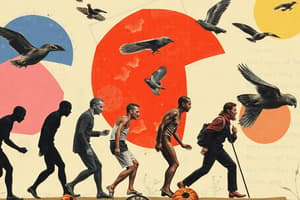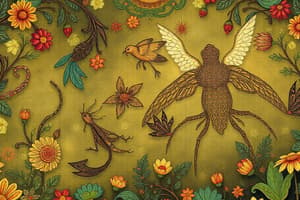Podcast
Questions and Answers
What is the primary difference between macroevolution and microevolution?
What is the primary difference between macroevolution and microevolution?
- Macroevolution occurs over short time periods, while microevolution takes millions of years.
- Macroevolution occurs at the population level, while microevolution occurs within a species.
- Macroevolution can be directly observed, while microevolution is not observable.
- Macroevolution involves large-scale changes leading to new species, while microevolution involves small-scale changes in gene frequencies. (correct)
Which of the following is NOT a mechanism of macroevolution?
Which of the following is NOT a mechanism of macroevolution?
- Natural Selection
- Mutation
- Artificial Selection (correct)
- Genetic Drift
Which level of evolutionary change does microevolution occur at?
Which level of evolutionary change does microevolution occur at?
- Interspecific level
- Population level (correct)
- Family level
- Species level
What type of evidence is often required to detect macroevolutionary changes?
What type of evidence is often required to detect macroevolutionary changes?
Which example best illustrates macroevolution?
Which example best illustrates macroevolution?
What is suggested as a plausible mechanism to diversify morphology during animal evolution?
What is suggested as a plausible mechanism to diversify morphology during animal evolution?
Which chromosome contains the HOXB cluster of Hox genes in humans?
Which chromosome contains the HOXB cluster of Hox genes in humans?
What effect does the mis-expression of Ubx in the second thoracic segment have on flies?
What effect does the mis-expression of Ubx in the second thoracic segment have on flies?
How do Hox genes contribute to transitions in animal axial pattern?
How do Hox genes contribute to transitions in animal axial pattern?
What is one method of macroevolution aside from mutation?
What is one method of macroevolution aside from mutation?
What is the consequence of Ubx loss-of-function mutations in flies?
What is the consequence of Ubx loss-of-function mutations in flies?
The divergence of six-legged insects from crustacean-like ancestors is traced back to approximately how many years ago?
The divergence of six-legged insects from crustacean-like ancestors is traced back to approximately how many years ago?
What role does gene flow serve in evolutionary biology?
What role does gene flow serve in evolutionary biology?
What can gene flow result from?
What can gene flow result from?
What is a significant consequence of genetic drift?
What is a significant consequence of genetic drift?
How does natural selection contribute to evolution?
How does natural selection contribute to evolution?
During genetic drift, what might happen to a population's alleles?
During genetic drift, what might happen to a population's alleles?
What was Charles Darwin's main contribution to the theory of evolution?
What was Charles Darwin's main contribution to the theory of evolution?
In the context of genetic drift, what does the term 'population' refer to?
In the context of genetic drift, what does the term 'population' refer to?
Which of the following best describes the outcome of natural selection?
Which of the following best describes the outcome of natural selection?
What role can brown coat color alleles play in a rabbit population due to genetic drift?
What role can brown coat color alleles play in a rabbit population due to genetic drift?
Flashcards
Macroevolution
Macroevolution
Large-scale evolutionary changes that occur over long periods, resulting in the formation of new species or major evolutionary trends.
Microevolution
Microevolution
Small-scale changes in gene frequencies within a population over short periods, driven by factors like mutation, selection, gene flow, and genetic drift.
Coevolution
Coevolution
The process where two or more species evolve in response to each other, often leading to a close relationship and interdependence.
Natural Selection in Macroevolution
Natural Selection in Macroevolution
Signup and view all the flashcards
Cumulative Microevolution
Cumulative Microevolution
Signup and view all the flashcards
Gene Flow
Gene Flow
Signup and view all the flashcards
Genetic Drift
Genetic Drift
Signup and view all the flashcards
Natural Selection
Natural Selection
Signup and view all the flashcards
Speciation
Speciation
Signup and view all the flashcards
Allele Frequency Changes
Allele Frequency Changes
Signup and view all the flashcards
Population
Population
Signup and view all the flashcards
Gene Pool
Gene Pool
Signup and view all the flashcards
What are Hox genes?
What are Hox genes?
Signup and view all the flashcards
How can mutations in Hox genes affect body plan?
How can mutations in Hox genes affect body plan?
Signup and view all the flashcards
How are Hox genes expressed along the body axis?
How are Hox genes expressed along the body axis?
Signup and view all the flashcards
How can Hox protein function contribute to morphological diversity?
How can Hox protein function contribute to morphological diversity?
Signup and view all the flashcards
How does the Ubx gene control wing development in Drosophila?
How does the Ubx gene control wing development in Drosophila?
Signup and view all the flashcards
What are halteres and how do they relate to Hox gene mutations?
What are halteres and how do they relate to Hox gene mutations?
Signup and view all the flashcards
What is gene flow and how does it relate to evolution?
What is gene flow and how does it relate to evolution?
Signup and view all the flashcards
How can gene flow contribute to diversity?
How can gene flow contribute to diversity?
Signup and view all the flashcards
Study Notes
Macroevolution vs. Microevolution
- Microevolution: Small-scale changes in gene frequencies within a population over a short period. Occurs at the intraspecific level (within a species).
- Macroevolution: Major or large-scale evolutionary changes over a large period of time. Occurs at the interspecific level (above the species level).
Key Differences
-
Definition: Microevolution describes small-scale changes in gene frequency, while macroevolution describes large-scale evolutionary changes.
-
Level: Microevolution occurs within a species or population, while macroevolution occurs above the species level.
-
Range: Microevolutionary changes occur within the range of a species, while macroevolutionary changes result in new species formation.
-
Causes: Microevolution is driven by mutations, natural or artificial selection, genetic drift, and gene flow. Macroevolution is due to extended microevolutionary processes.
-
Detection: Microevolutionary changes are directly observable through experimental evidence. Macroevolutionary changes may require fossil evidence.
-
Examples: Microevolution examples include bacterial resistance to antibiotics. Macroevolution examples include the evolution of bat wings and the loss of limbs in snakes and lizards.
Mechanisms of Macroevolution
-
Mutation: Alterations in the genetic code may result in new traits. Homeotic (Hox) genes are crucial in controlling body plan development in animals. Mutations in them can drive morphological evolution. Gain or loss of Hox protein functions alters morphology.
-
Migration or Gene Flow: The movement of individuals or genes between populations can alter allele frequencies in both populations. This can lead to adaptation to different environments and evolution.
-
Genetic Drift: Random fluctuations in allele frequencies, particularly in small populations. These can eliminate rare alleles and lead to genetic divergence between populations.
-
Natural Selection: The process by which organisms better adapted to their environment are more likely to survive and reproduce, thus passing on traits to future generations. Natural selection drives adaptation and speciation. This can be demonstrated in examples like Darwin's finches that evolved unique traits to adapt to different food sources.
Studying That Suits You
Use AI to generate personalized quizzes and flashcards to suit your learning preferences.




